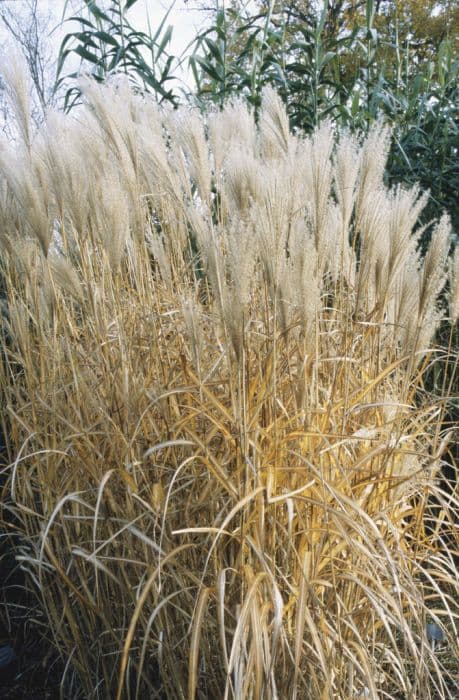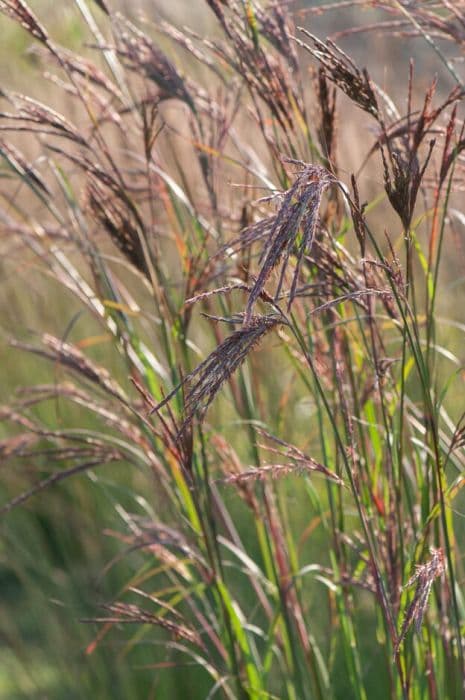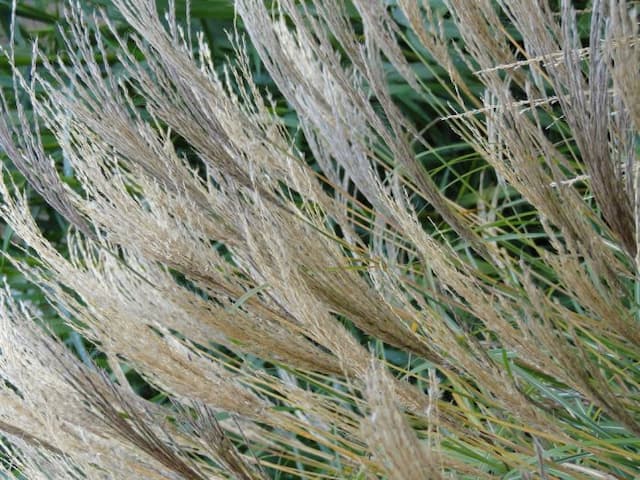Variegated Velvet Grass Holcus mollis 'Albovariegatus' (v)

ABOUT
Holcus mollis 'Albovariegatus', often known as variegated creeping soft grass, is a perennial grass marked by its attractive foliage. The plant features long, slender leaves that exhibit a soft texture. These leaves are notable for their variegation, displaying a mix of green and white or cream shades that can form stripes or a more mottled pattern along the leaf blade, making it a visually striking choice for gardeners looking to add some lightness or contrast to their plantings. The variegation can vary from leaf to leaf, with some exhibiting more white and others more green, providing a dynamic and sometimes almost shimmering effect when touched by the breeze. The edges of the leaves typically show a more pronounced white or cream variegation, which can give the plant a glowing appearance in the right lighting conditions. This cultivar of creeping soft grass has a growth habit that tends to be clumping, with the plant spreading outwards gracefully from the center. The leaves often cascade softly, creating a gentle, weeping effect that adds to the plant’s overall elegance. During its blooming period, Holcus mollis 'Albovariegatus' might produce subtle flower heads that add another layer of interest to the plant, but it is primarily grown and appreciated for its ornamental foliage that shines in garden beds, borders, or as part of decorative plant arrangements.
About this plant
 Names
NamesFamily
Poaceae.
Synonyms
Variegated Velvet Grass, Silver-veined Wood Grass, Striped Wood Grass, Creeping Soft Grass.
Common names
Holcus mollis var. albovariegatus, Holcus mollis 'Variegatus'.
 Toxicity
ToxicityTo humans
The plant known as Velvet Grass is generally not considered toxic to humans. There are no well-documented cases of poisoning from ingesting this plant, and it is not known to cause severe adverse effects if handled or accidentally ingested in small quantities.
To pets
Velvet Grass is also not commonly known to be toxic to pets. It is not listed as a plant that is hazardous to cats, dogs, or other domestic animals. However, ingestion of any plant material can potentially cause mild gastrointestinal upset in pets, including symptoms such as vomiting or diarrhea, so it is always prudent to prevent pets from eating plants indiscriminately.
 Characteristics
CharacteristicsLife cycle
Perennials
Foliage type
Deciduous
Color of leaves
Variegated
Height
2 feet (60 cm)
Spread
2 feet (60 cm)
Plant type
Grass
Hardiness zones
5
Native area
Europe
Benefits
 General Benefits
General Benefits- Ornamental Appeal: Holcus mollis 'Albovariegatus', commonly known as the Variegated Velvet Grass, adds visual interest to garden spaces with its striped, variegated leaves that can brighten up shaded areas.
- Shade Tolerance: It is well-suited for growing in shaded parts of the garden where few other plants may thrive.
- Soil Versatility: Variegated Velvet Grass adapts to a wide variety of soil types, though it prefers moist, well-drained ground.
- Easy Propagation: It can be easily propagated through division, allowing gardeners to spread the plant throughout their garden without the need for purchasing new plants.
- Low Maintenance: Once established, it requires minimal care apart from occasional watering during dry periods and cutting back before new spring growth.
- Garden Structure: Its foliage provides texture and can serve as a backdrop for more vibrant flowering plants, contributing to the overall structure and design of a garden.
- Ground Cover: It can be used as ground cover to help prevent soil erosion and suppress weeds when planted densely.
- Wildlife Support: While not its primary benefit, it can offer some habitat support for insects and small wildlife within a diverse garden ecosystem.
- Seasonal Interest: The plant can provide year-round interest, but particularly stands out during the spring and summer when its foliage is most vibrant.
 Medical Properties
Medical PropertiesThis plant is not used for medical purposes.
 Air-purifying Qualities
Air-purifying QualitiesThis plant is not specifically known for air purifying qualities.
 Other Uses
Other Uses- Craft Material: The variegated leaves of ‘Velvet Grass’ can be used in floral arrangements and crafts, providing a contrasting texture and color to projects.
- Garden Borders: Gardeners can plant ‘Velvet Grass’ at the edges of garden beds to create a natural, variegated border that contrasts with other plants.
- Photography: Photographers might utilize ‘Velvet Grass’ as a backdrop or subject in garden photography, taking advantage of its distinctive leaves.
- Fabric Dye: The leaves of ‘Velvet Grass’ could potentially be used in the natural dyeing process to achieve subtle color variations in fabrics.
- Erosion Control: ‘Velvet Grass’ can help stabilize soil in garden areas prone to erosion due to its spreading habit.
- Education: Botany educators may use ‘Velvet Grass’ to teach about plant variegation and ornamental grass characteristics.
- Ecological Studies: Because of its growth habit, ‘Velvet Grass’ can be a subject of study in ecology to understand the impact of non-native species in certain environments.
- Ground Cover: ‘Velvet Grass’ can be planted in large patches to serve as a lush ground cover that helps suppress weeds.
- Wildlife Habitat: ‘Velvet Grass’ can provide shelter for small animals and insects within garden ecosystems.
- Seasonal Interest: ‘Velvet Grass’ can add visual interest to winter gardens with its persistent variegated foliage during the colder months.
Interesting Facts
 Feng Shui
Feng ShuiThe Velvet Grass is not used in Feng Shui practice.
 Zodiac Sign Compitability
Zodiac Sign CompitabilityThe Velvet Grass is not used in astrology practice.
 Plant Symbolism
Plant Symbolism- Flexibility: Holcus mollis 'Albovariegatus', commonly known as Variegated Velvet Grass, has a pliable and bending structure, symbolizing adaptability and resilience in various situations.
- Survival: As a grass that can thrive in different conditions, it represents the ability to survive and prosper despite challenges.
- Tranquility: With its soft, velvety texture and calming green and white foliage, it evokes a sense of peace and serenity.
- Growth: Grasses are often associated with continuous growth and development, reflecting the idea of personal evolution and improvement.
- Grounding: As a plant that is close to the earth, it can symbolize staying grounded and connected to one's roots or the physical world.
 Water
WaterThe Variegated Velvet Grass should be watered deeply but infrequently, ensuring that the soil is moist but not waterlogged. Aim to water every 7 to 10 days, allowing the top inch of soil to dry out between waterings. During the active growing season in spring and summer, the plant may need more frequent watering, about once per week, depending on climate conditions. Use approximately 1 gallon of water for medium-sized plants; adjust according to plant size and environmental factors. Decrease the frequency of watering in the fall and winter when the plant's growth slows down.
 Light
LightVariegated Velvet Grass prefers partial shade to full sun conditions. This grass will thrive in a spot that receives morning sunlight with protection from the intense afternoon sun, or in dappled sunlight beneath taller plants or trees. Too much direct, harsh sunlight can scorch the leaves, while too little light may cause the variegation to fade.
 Temperature
TemperatureVariegated Velvet Grass grows best in temperatures between 60 and 75 degrees Fahrenheit. It can tolerate a range from 50 to 80 degrees Fahrenheit but will suffer if temperatures go below 50 or above 80 degrees Fahrenheit for extended periods. The plant is somewhat cold hardy, but for optimal health, maintain it within the ideal temperature range.
 Pruning
PruningPrune Variegated Velvet Grass to control its size and shape and to remove any brown or damaged foliage. The best time for pruning is in late winter or early spring before new growth begins. Pruning can be done annually to encourage fresh, healthy growth and to maintain the plant's appearance.
 Cleaning
CleaningAs needed
 Soil
SoilCreeping velvet grass thrives in a well-draining soil mix rich in organic matter with a pH of 5.5 to 7.0. A mix of loam, peat, and sand is ideal to retain moisture while avoiding waterlogging.
 Repotting
RepottingCreeping velvet grass should be repotted every 1-2 years to refresh the soil and accommodate growth, doing so in spring as new growth appears.
 Humidity & Misting
Humidity & MistingCreeping velvet grass prefers moderate to high humidity levels but is quite adaptable to different humidity conditions found in typical homes.
 Suitable locations
Suitable locationsIndoor
Place creeping velvet grass in bright, indirect light and keep soil moist.
Outdoor
Grow in partial shade, moist soil, and shelter from harsh winds.
Hardiness zone
5-9 USDA
 Life cycle
Life cycleHolcus mollis 'Albovariegatus', commonly known as Variegated Velvet Grass, initiates its lifecycle when seeds germinate in the spring, given adequate soil moisture and light conditions. The seedlings develop into clumps of variegated green and white grass-like foliage, with the plant thriving in well-drained soil and partial shade to full sun. As it matures in late spring to early summer, the plant sends up flowering stems that display airy panicles of small, pale pink to purplish flowers. Following pollination, these flowers produce seeds by late summer, facilitating the spread of the plant, either by self-sowing or through human intervention. In the autumn, the foliage of Holcus mollis 'Albovariegatus' may die back, especially in colder climates, though it is a perennial grass and will regrow from its rhizomatous root system the following spring. Throughout its lifecycle, the plant can also propagate vegetatively by division, a method often used by gardeners to maintain desired plant size and to establish new plants.
 Propogation
PropogationPropogation time
Spring-early summer
The Variegated Velvet Grass typically propagates through division, a method both straightforward and effective for this perennial plant. Ideally, division should occur during the plant's dormant period, which is generally in the early spring or fall. To divide Variegated Velvet Grass, you first need to dig up the entire plant, making sure to keep a substantial amount of soil surrounding the root ball to minimize root damage. Using a sharp spade or garden knife, you would then carefully slice through the root ball to separate it into smaller sections, each with its own roots and shoots. It's crucial to ensure that each division has a healthy amount of roots to facilitate successful re-establishment when planted. These new divisions should then be planted promptly into prepared garden beds or pots filled with potting mix, spaced about 18 inches (approximately 45 centimeters) apart to give each plant ample room to grow. After planting, thorough watering is essential to help settle the soil around the roots and eliminate any air pockets.









